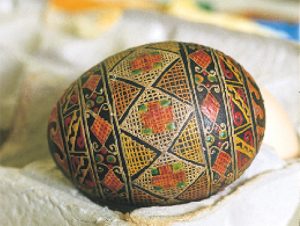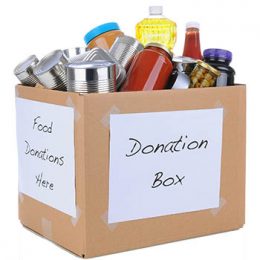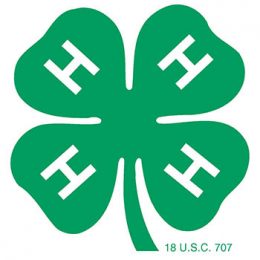(This story appeared in the March 1997 issue of Electric Consumer. Maria Fedyniak passed away in October 2005 at the age of 83.)

Maria Fedyniak’s Easter basket is filled with the beautiful eggs she learned to create as a girl in her native Ukraine. Traditionally, the eggs are created to celebrate Easter and life’s rites of passage, and given as gifts, like greeting cards, to friends and family.
When Maria Fedyniak was a little girl growing up on a little farm in Ukraine, the egg was always something special.
Sometimes, she said, eggs were like money. Her family used them to barter for other goods they needed from the nearby village.
And at Easter time, they colored eggs in the Ukrainian Christian tradition to celebrate the resurrection of Jesus Christ and the rebirth of man. Maria’s mother and grandmother taught her their cherished custom called “pysanky.”
Pysanky are intricate colorful designs created on the egg shell through the layering of beeswax and dyes. The geometric shapes, floral and animal figures, even the eggs, are steeped in symbolism. “In our country, everything has meaning,” Maria said, “and we treasure that.”
The ornate eggs were used as gifts and greetings. They were used to decorate the home, and, it was believed, to even protect the home from evil.
Today, Maria is far away and almost a lifetime removed from the little village of her youth. But from her home in rural Jasper County, she continues to celebrate Easter and send wishes with the traditional eggs of her native land.
“To me, it’s a heritage,” she said of the tradition that’s so old “it can’t walk by itself.” That’s why it’s been carried on in the steady and skillful hands of Ukrainian immigrants everywhere and shared with others eager to learn its eternal beauty.
As Easter approaches, the Jasper County REMC member will once again be sharing that heritage at schools, clubs and churches. In northwestern Indiana, Maria is affectionately known to many youngsters as the “Easter Egg Lady.”
“It was almost a lost art,” she said. “I’m so glad children have picked it up.”
One place Maria will be teaching the art is a grade school in nearby Wheatfield. Gail Woolever, the art teacher there, found out about the talented artist 12 years ago. She’s invited Maria over for an afterschool workshop each Lenten season since.
“It’s branching out. Every year we have three or four (students) who continue on with it,” Gail said.
“It is like in the Bible, you throw seeds and some take,” Maria said of those who keep up the tradition. “I know that I’ll leave something behind me.”
Even the students who make no other eggs after the class learn valuable lessons. “At least they know the process that goes into it,” Gail said. And they learn the value placed on traditions.
“A country without tradition is like a house without a foundation,” Maria said.
One of Maria’s most devoted and succesful “students” has been the art teacher herself.
“It was something that was passed down mother to daughter,” said Gail, who is also a Jasper County REMC member. And she noted that’s what her relationship with Maria is like. “Every time she teaches, I still learn more.”
‘Little gems’

Early in the coloring of this egg, Maria “draws” melted beeswax onto the areas that are to remain yellow. When those areas are covered, she’ll soak the egg in the next darker dye, such as orange. Then she’ll cover areas that are to be orange with wax and move on to the next darker dye. The green highlights were dabbed on by hand.
To create her pysanky designs, Maria first lightly sketches the basic outlines on the eggshell in pencil. She divides the surface with straight lines, triangles, squares and belts. “And then,” she said of the detailed work with wax, “it comes by itself.”

The final step: Maria takes the egg covered in dye and wax and heats it to melt the wax. She then wipes off the wax with a soft absorbent cloth to reveal the brightly colored “pysanky” design of the Ukrainian Easter egg.
“They’re so intricate, but they’re all just basic shapes,” Gail said. “The complexity builds up and just makes them beautiful little gems.”
The melted beeswax is drawn onto the egg with a stylus called a “kistka.” The parts of the egg that are dyed are the parts not protected with wax. The colors are applied successively from light to dark. The whole process will take seven to 12 hours.
Once the dyeing is done, the egg is warmed over a flame to melt the wax and wiped in a soft cloth. A thin coat of varnish adds luster and protection.
Though mechanization and even computer design are starting to sneak into eggs done by some folks, Maria still does all of her eggs painstakingly by hand. Each little ribbon that loops the egg, each line, each wavy scroll and speckle, all created by threads and beads of beeswax. “The eyes are failing and hands are trembling,” she said, “but somehow I do it.”
Maria will be creating three to four dozen eggs for a Ukrainian charity bazaar in Munster the day before Palm Sunday. Her eggs sell for $10 and up. “I can’t contribute money, but I can contribute something else,” she said.
She also will be demonstrating the art at several craft festivals in the northwestern pocket of the state throughout the year. She’s enlisted Gail to help her cover some of the events.
Wishes for others
The pysanky tradition developed over centuries, passed on mostly by country women. Eggs were exchanged Easter morning with friends and relatives and given at other times as tokens of love. Once given, they would be prominently displayed in homes and treasured for years.

Maria Fedyniak’s Easter basket and home are filled with the artistic, intricate — and symbolic — eggs of her native Ukraine.
“They didn’t have greeting cards, so this was their wish for others,” Gail said. The symbols on the eggs were tailored to fit the recipient and event. “They’re just closely associated with all the rites of passage: death, birth, weddings, illness,” she said.
Maria said if a person likes to sing, she might put song birds on the egg, for example. For a golden wedding anniversary of friends, recently, she included golden ribbons, for an unbroken eternal bond, and bees, because the couple had toiled so hard all of their lives.
For a newborn baby, she created an egg with ram’s horns, a wish for leadership and strength to overcome problems, and evergreens for health and stamina. She colored the egg in mostly red for happiness in life, hope and passion.
As tradition suggests, Maria’s pysanky wishes for others do come to pass. At a shop where some of her eggs were being sold one time, Maria saw a young couple who seemed unhappy.
“I noticed her eyes. She was crying and they were separated,” Maria said. “I’m not a gypsy, but I sensed something wrong there.”
She took an egg over to the man. On it was a male deer standing and a female deer reclining on the grass and a vine wrapped around a tree. She explained the symbols to him: the male deer protecting the female, and the female calming the male. The vine represented calmness in life.
She told him she hoped their bond would never be broken. “He thanks me and he puts his hand on her middle,” Maria said. And they walked off together.
Sometime later, the young woman visited Maria and said that her simple gift and wish for them made a difference in their lives and they worked things out. “She comes with the egg by herself and said, ‘I’m very happy you told that story.’”
When Maria shares the stories of her eggs, it’s easy to see why she spends so much time and energy creating them; she gets as much joy from giving her eggs as the lucky recipients get from receiving them.
Maria also has designed eggs for other holidays. Prodded by her REMC meter reader, she entered two eggs in the Electric Consumer’s Christmas Ornament Contest in December. Her eggs placed third (out of 140 entries) in the statewide contest. There, she used a dove holding an olive branch as a symbol and a wish for world peace. On an accompanying egg, she rendered the Nativity.
Once, she and her classmates back in the Ukraine created eggs for an art teacher who had died. They each brought their egg, 14 in all, and placed them beside the woman in her casket. “It was like a rosary around her and by her side,” she said — an image she’ll never forget.
A bridge to cross
When Maria was growing up, creating the eggs was a must at Easter. Ukrainians believed that by creating the beautiful eggs and having them blessed by a priest, evil was kept at bay. “Grandmother always said if you don’t do an egg at Easter, the devil was going to lose his chains and something terrible would happen,” she said.
Maria is reluctant to talk about the separation from her homeland. Memories of the hardships and loss bring tears to her eyes. But in the 1930s and 40s, the devil truly was unleashed on Europe, and terrible things happened. During World War II, Maria’s village became a war zone and was occupied by Germany. Displaced by the war, her family was scattered and she was interned at a refugee camp in western Germany.
There, she met Nick Fedyniak who was displaced from the Ukraine, too. After the war, they married. But instead of returning home, they sought a new life. Nick took a coal mining job in Belgium and they waited for the chance to come to America.
Nick tracked down an uncle who emigrated to the United States many years earlier. He and his family were living in Chicago. With his help and the help of a Catholic relief agency, Nick and Maria came to the United States in 1952. Both were 32 years old, had only $40 in their pocket and spoke no English. They moved to Chicago and found jobs.
Throughout the war years and the years in Belgium, life was so hard Maria said she never thought of making Easter eggs. But at that first Easter in America, she decided it was time for her to revive the custom.
She received beeswax from a friend who kept bees. For dyes, she had none of the traditional barks and onion skins used in the Ukraine. So, she boiled crepe paper. And she fabricated a rough stylus using the hollow metal end of a shoestring for a tip.
When she presented her eggs to Nick’s relatives, the memories and the link to the past overwhelmed the wife of the uncle. “She was crying because it had been so long,” Maria recalled.
Maria’s home today is filled with little mementos and trinkets of her Ukrainian heritage. But she said she has no regrets about where her life took her and her husband. She said she knows they came to a much better life in the United States than the one that was waiting in Soviet Ukraine after the war.
The two left Chicago in 1960 when they bought their own five acres of land in Jasper County. Maria took a job at an egg farm just down the road. “There I got to pick the best eggs,” she said. (Farm-fresh eggs are a key to quality pysanky designs, she said. The shells of store-bought eggs are too brittle and blemished.) She worked at the farm until her husband took ill 13 years ago. He died in 1984.
Maria visited Ukraine in 1976 when it was still under communist rule. Much of the life she knew there in the shadows of the Carpathian Mountains, including her village, was gone.
But a little bit of her heritage as a Ukrainian country girl is reborn each time a boy or girl, under her loving eye, traces a cross or slowly encircles a clean white egg with a ribbon of beeswax.
“This is like a bridge you cross from generation to generation,” she said of the pysanky tradition. “I hope that bridge never gonna break.”
RICHARD G. BIEVER is senior editor of Electric Consumer
For more information about pysanky eggs:
The Ukrainian Gift Shop is a leading manufacturer and distributor of quality supplies for decorating pysanky. Ukrainian Easter Eggs have a long history, and the Art of Pysanky is an integral part of the Ukrainian culture. The family-owned shop, based in Minneapolis, strives to provide the highest quality tools and supplies for decorating pysanky, in addition to providing books and accessories to introduce the art form to a beginner or to enhance the skills of an experienced artisian.




